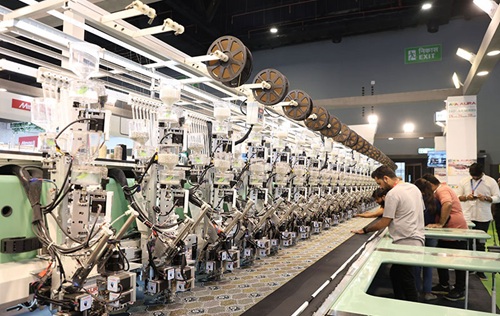The garment industry in India in 2025 is one of the country’s most vibrant and globally connected sectors — a key pillar of employment, exports, and industrial modernization. From traditional textiles to smart manufacturing and sustainable fashion, India’s garment sector is evolving rapidly, positioning itself as a competitive global hub amid shifting supply chains and rising domestic demand.

Overview: A Global Player in Apparel Manufacturing
As of 2025, India’s garment and apparel industry is valued at USD 80–90 billion, contributing nearly 5% to the country’s GDP and employing over 45 million people, making it the second-largest employment generator after agriculture. Of this, the export market accounts for around USD 20–22 billion, while the domestic market contributes nearly USD 60 billion.
India ranks among the world’s top five garment exporters, competing with countries like China, Bangladesh, and Vietnam. The nation’s strength lies in its integrated textile value chain — from raw cotton and synthetic fibers to ready-made garments and technical textiles. The post-pandemic recovery, government incentives, and a surge in demand for sustainable fashion are giving the industry a new growth trajectory in 2025.
Government Initiatives and Policy Push
The Indian government has been instrumental in shaping the future of the garment industry through targeted policies that enhance competitiveness and infrastructure. Key initiatives include:
- Production Linked Incentive (PLI) Scheme for Textiles: Launched with a budget of ₹10,683 crore, it aims to attract global investment and scale manufacturing in man-made fiber (MMF) garments and technical textiles.
- PM MITRA Parks (Mega Integrated Textile Region and Apparel): Seven large integrated textile parks are being set up across India to provide plug-and-play infrastructure, logistics support, and common facilities for garment units.
- RoDTEP and RoSCTL Schemes: Offer export incentives to boost global competitiveness and offset duties and taxes on export goods.
- Skill India and SAMARTH Programs: Focus on upskilling workers to meet modern apparel manufacturing standards.
These initiatives are not only enhancing productivity but also encouraging export diversification into new markets like the Middle East, Latin America, and Africa.
Domestic Market Dynamics: The Rise of Indian Fashion Consumers
The domestic apparel market in 2025 is booming, driven by India’s young population, rising incomes, and growing fashion consciousness. With over 65% of Indians under 35, lifestyle and fashion consumption are expanding beyond metros into Tier-II and Tier-III cities.
E-commerce has revolutionized garment retail, with platforms like Myntra, Ajio, Meesho, and Amazon Fashion bringing both global and regional brands to millions of consumers. Digital-first fashion startups are leveraging data analytics, AI-driven personalization, and sustainable production models to attract eco-conscious buyers.
Segments witnessing strong growth include:
- Athleisure and casual wear – fueled by work-from-home culture and fitness trends.
- Ethnic and fusion wear – growing as Indian consumers embrace cultural roots in modern silhouettes.
- Kidswear and women’s fashion – expanding rapidly in both online and offline formats.
By 2025, India’s domestic apparel market is projected to cross USD 100 billion by 2030, signaling a shift from low-cost clothing to value-driven fashion.
Export Outlook: Strengthening Global Competitiveness
India’s garment exports have recovered steadily after pandemic-related disruptions, supported by supply chain diversification away from China and trade pacts with key regions. Major export destinations include the U.S., EU, UK, UAE, and Japan.
To strengthen competitiveness, Indian manufacturers are investing in automation, digital design, and sustainability certification. Global retailers are increasingly sourcing from India due to its skilled labor, diversified product range, and improving compliance standards.
The PLI and MITRA initiatives are expected to push India’s apparel exports beyond USD 30 billion by 2026, making it a central player in global fashion supply chains.
Technology and Innovation: The New Fabric of Growth
The Indian garment sector is witnessing a major technological shift:
- Automation and Industry 4.0: Smart cutting, stitching, and quality inspection systems are improving efficiency and reducing waste.
- Digital Sampling and 3D Design: Shortens product development cycles and reduces material use.
- Sustainable Textiles: Use of organic cotton, recycled polyester, and eco-friendly dyes is rising across export clusters like Tiruppur, Surat, and Ludhiana.
- Blockchain and Traceability: Brands are adopting traceability platforms to meet international sustainability standards.
These innovations are helping Indian apparel producers compete not just on cost but also on speed, quality, and environmental responsibility.
Challenges: Threads That Need Fixing
Despite its strong fundamentals, the garment industry faces several challenges in 2025:
- High input costs: Cotton price fluctuations and rising energy costs affect margins.
- Labor and skill gaps: Automation demands new skill sets that require large-scale retraining.
- Fragmented structure: Over 70% of the industry consists of small-scale units with limited access to finance and technology.
- Global competition: Nations like Bangladesh and Vietnam offer lower costs and preferential trade access.
Addressing these issues through better logistics, financial inclusion, and innovation incentives will be key to sustaining competitiveness.
The Road Ahead: Sustainable and Inclusive Growth
By 2025, the Indian garment industry is not only growing in size but also transforming in character. Sustainability, ethical sourcing, and digital transformation are defining the next phase of growth. The increasing participation of women entrepreneurs and small businesses is adding inclusivity to the sector’s success story.
If current policy and investment trends continue, India’s garment industry could reach USD 150 billion by 2030, driven by domestic consumption, export expansion, and sustainable innovation.
Conclusion: Weaving a Global Legacy
The garment industry in India in 2025 is more than an economic engine — it’s a story of resilience, creativity, and modernization. With the right mix of technology, sustainability, and policy support, India is poised to strengthen its position as a global apparel powerhouse.
From cotton fields to couture runways, the Indian garment sector is weaving not just clothes, but the very fabric of the nation’s economic future.

